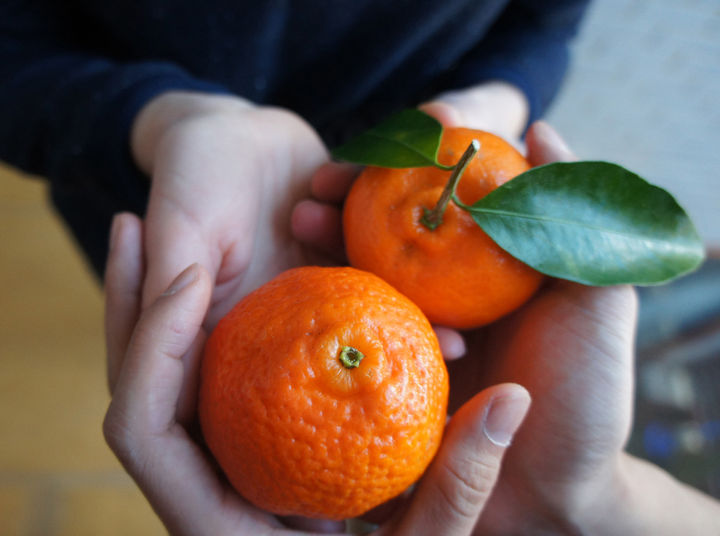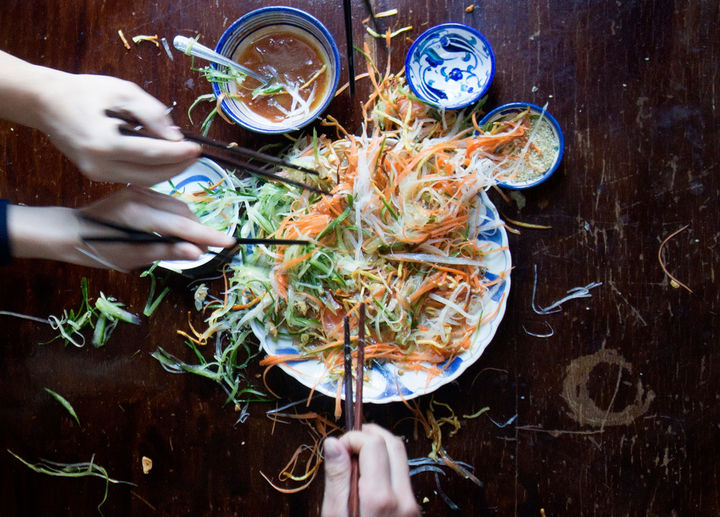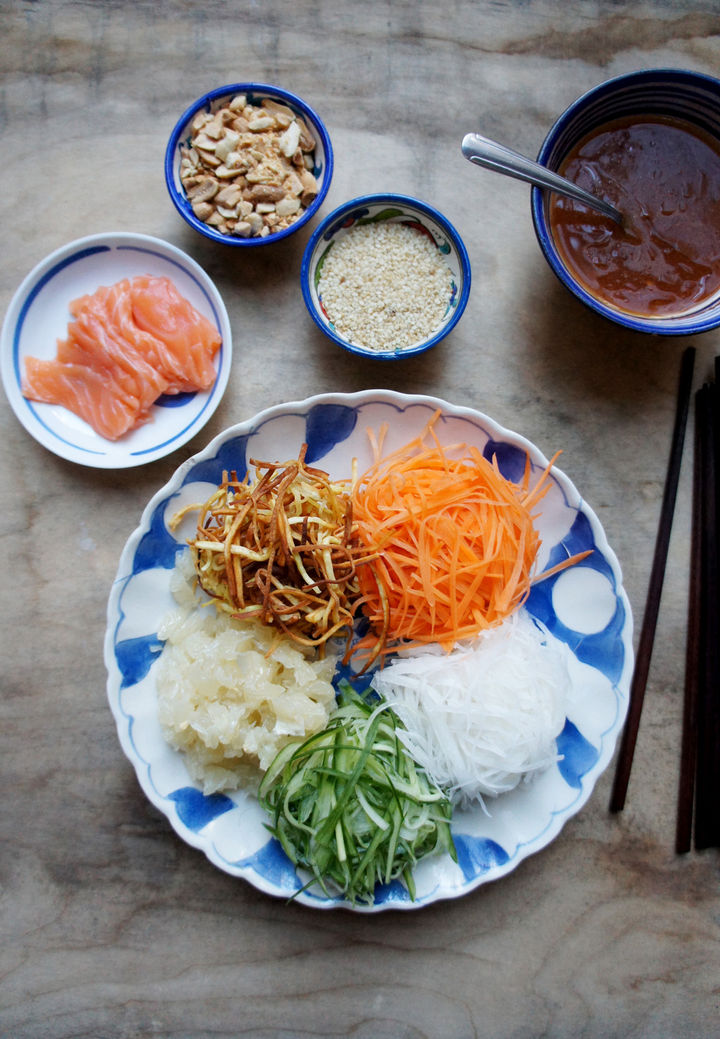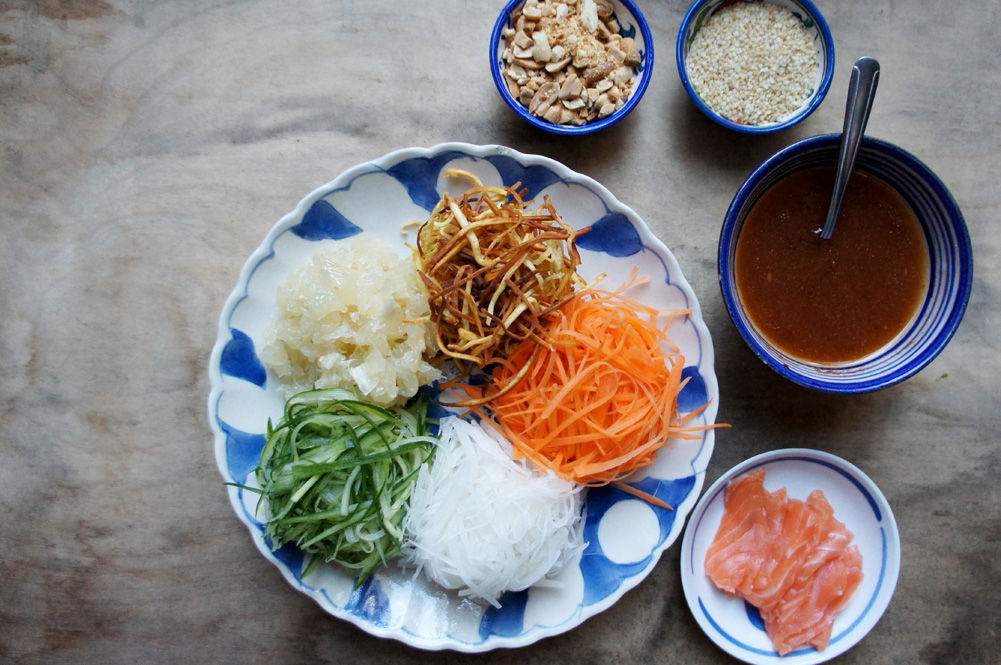Traditionally, Chinese New Year focuses on gathering family and friends together over good food and conversation, so hosting your own Chinese New Year party is a great way to get everyone together, as well as a brilliant excuse to try your hand at a different cuisine.
There are lots of dishes you can make, but one way to ensure everyone gets involved in your feast is to focus on party favourite Yu sheng.
TRADITIONAL FOOD
The food on offer at Chinese New Year is typically symbolic of prosperity and togetherness. Fish, for instance, translates to “abundance” in Chinese; while dumplings represent wealth because they look like traditional gold ingots. Dumplings are also a great excuse to rally the family and try your hand at making them together.
Another of my favourite traditions is the exchange of mandarin oranges when visiting a relative’s home. You can adapt this as a fun party rule for your guests: tell them to bring a couple of mandarin oranges in addition to the obligatory six-pack of beer or bottle of wine!

SALAD PARTY
Chinese immigrants all over the world celebrate Chinese New Year, all bringing something different to the party depending on influences from other cultures in their community. A dish that’s quite specific to Singapore and Malaysia is “yu sheng”, a raw fish salad with a dizzying mix of shredded colourful vegetables and a plum sauce-based dressing. What’s really exciting about the dish is that it involves the combined wrist power of all your guests…
Yu sheng starts out beautifully pristine, each component sitting in a neat little coloured mountain. Everyone then gathers around with a pair of chopsticks and at the indication of the host, digs in with fury, tossing the salad as high as possible while shouting their wishes for the new year. As a kid, over-eager little me would climb onto a chair and gleefully wave my chopsticks above the adults, screaming about acing my exams. I worry and scream about different things now, but the salad party remains a yearly tradition.

The original salad consists of an intimidating total of 27 “prosperous” ingredients, including raw salmon, different varieties of shredded vegetables, pickles, roasted peanuts, sesame seeds and fried crackers. Rather than give up on this Chinese New Year tradition altogether, I’ve simplified and adapted the recipe so you can easily recreate yu sheng with ingredients that are readily available where you live. Feel free to add or swap any of the traditional vegetables used with your favourite colourful crisp vegetables.
HOW TO MAKE YU SHENG
Chinese New Year tossed raw salmon salad with plum sauce dressing

Serves 4 to 6
1 sweet potato (200g)
1 large carrot (200g)
1 small daikon radish (200g)
1 large cucumber (200g)
200g pomelo*
100g raw salmon sashimi, from sustainable sources
Groundnut oil, for frying
TOPPINGS
30g sesame seeds
30g roasted peanuts
SAUCE
1 lime
200g plum sauce*
2 teaspoons sesame oil
¼ teaspoon five spice powder
- Peel the sweet potato, then coarsely shred all the vegetables on the thick side of a box grater. Alternatively, use a speed-peeler to get thin slices, before julienning to get thin strips.
- Peel the pomelo and break the sacs up.
- Thinly slice the salmon.
- Add oil to a hot wok or pot and when the oil is hot, deep fry the shredded sweet potatoes till cooked – it doesn’t need to be crisp and golden!
- Drain on kitchen paper.
- Arrange all the salad ingredients on a large serving platter, with the different ingredients and colours grouped together in their own little coloured section.
- Toast the sesame seeds in a dry frying pan, then scatter over the salad.
- Crush and scatter over the peanuts.
- Squeeze 2 tablespoons of lime juice in a separate tiny bowl or jug. Add the remaining sauce ingredients and 1 big pinch of sea salt and white pepper.
- Gather your friends and family around. Scatter the toppings over and drizzle the sauce over– with a dramatic flourish. Have everyone dig in with chopsticks, tossing the salad and mixing everything up as you do so.
- Once everything is mixed, tuck in, making sure to get a bit of every ingredient in each bite.
*Pomelo is a citrus that looks like oversized grapefruits. It tastes similar but is less bitter and has a fragrant sweetness. If you can’t get hold of it, use grapefruit segments, tossed with a bit of sugar.
*Plum sauce is available from most Asian grocers. If you can’t get hold of plum sauce, use the same amount of your favourite marmalade with extra lime juice stirred in. It won’t taste exactly the same, but is a delicious dressing that works well with the rest of the ingredients.























